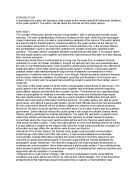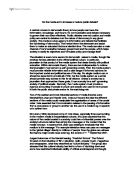Habermas added historical grounding to the institute theory, arguing that a ‘refudalisation ‘ of the public sphere began occurring in the late 19th century. The major change involved private interests assuming direct political functions, as powerful corporations came to control and manipulate the media and state. On the other hand, the state began to play a more fundamental role in the private realm and everyday life, thus eroding the difference between state and civil society, between the public and private sphere.
For Habermas, the function of the media has been transformed from facilitating rational discourse and debate within the public sphere into shaping, constructing and limiting public discourse to those themes validated and approved by media corporations. Hence the interconnection between a sphere of public debate and individual participation has been broken and transformed into that of a realm of political information and presentation, in which citizen-consumers absorb and consume passive entertainment and information. Therefore ‘citizens’ mould public opinion by becoming spectators of media presentations, reducing citizens to objects of news, information and public affairs.
However critics have argued that while rational discussions and debates took place, certain groups were in fact excluded therefore limiting participation. Habermas acknowledges that he presents a ‘stylized picture of the liberal elements of the bourgeois public sphere’ and should have made it clearer that he was establishing an ‘ideal type’ and not a normative ideal to be resuscitated and bought back to life.
Moreover, while the concept of the public sphere and democracy assume a liberal celebration of diversity, tolerance, debate and consensus, in actuality the bourgeois public sphere was dominated by white, property owning males. As Habermas’s critics have documented, working class, ordinary, and women public spheres developed alongside of the bourgeois public sphere to represent voices and interests excluded in this forum.
Calhoun (1992-ibid) however critisized Habermas’s theory and thought that the public sphere depicted by Habermas has probably never even existed, and that his picture of the debates in the coffee houses is an unhelpful idealization, and the massification of the media did not have the disastrous impact on the public debate that Habermas claims it did. (Goldsmith media group, page 40- in Media Organisations in society. Edited by James Curran). Other criticisms were also raised which attacked the very basis of Habermas’s position. For example it was argued that even if the bourgeois public sphere did exist as claimed by Habermas, it was far from being ideal, it was actually most probably based upon exclusions, such as ethnic minorities and many more. Habermas continues to insist that the ideal public sphere should be based on bracketing out the ‘private differences’ but he ignores the social forces that determine which differences are bracketed out. Calhoun argues once again, that any public sphere is necessarily a socially organised field, with characteristic lines of division. Benhabib - a feminist critique of Habermas, believes that he tends to over emphasis the importance of ‘rational’ debate in the public sphere rather than confront the distortions around who has been seen as ‘qualified’ to take part in ‘rational’ debate. John Thompson (1993 Media organisations in society, page 41. James Curran) also found much to complain about Habermas’s theory, arguing that Habermas’s theory is out of date.
Capitalism during the 19th century ushered in a mass culture that was based upon standardization, co- modification and conformity. As time has gone by, the informational capitalism has meant advertising; magazines and television programs have become more explicit targeted in terms of certain lifestyle niches. This has meant that capitalism has become less associated with a culture of mass conformity than with catering of products to meet the preferences of explicit population groupings. Increasingly television programs, advertisement, magazines and films are produced with the culture make up of a particular audience segment in mind.
Since the advent of the printing press the idea of the nation has been a relatively permanent feature within the popular imagination. The developments of the press and television have all been specifically ‘national’ in focus, ownership and control. Many television programs, films and newspapers took the idea of a recognizable national identity for granted while symbolically contributing to its construction.
The role of the media in the shaping of the public sphere as opposed to commercial and national cultures is an important one. While nations of the public grew up with capitalism, and the nation, they remain analytically independent. Ideas of the public meant that the media had an obligation to provide information that would embarrass nation-states, blow the whistle on the exploits of capital and allow a diverse community critically to debate the important issues of the day. Habermas’s (1996-The transformation of the media-Globalization, morality and ethics- page 42, Nick Stevenson) defines the public sphere by its dynamic and spatially complex nature. Habermas maintains his median roots by continuing to link the cognitive capacity of the self and the institutional mechanisms of society in the promotion of a critical pluralistic culture. The distinction between ethics (question of what’s right) and morality (question of what’s right in the community) means that the public sphere is continually involved in a process of deciding what can reasonably be decided by the community and what can not. The primary task of the public sphere, is the detection and identification of public problems that lead to be fed into procedures of parliament and the state. The public sphere in the modern media age operates as a signaling device that highlights matters of public importance that have to be described upon the structures and representative democracy. Public opinion is not so much the result of opinion polls but proceeds a period of proper focused debate. Habermas (ibid) argues that an agreement can only emerge after a period of what he calls ‘exhaustive controversy’. However, Habermas is clear that such wide-spread discussions only become converted into communicative power once they pass through the institutional matrix of democratic will formation. From this statement we can say that public opinion is activated once the various interactive agencies of state and civil society have become focused on a particular problem. An informed public culture in this respect is built upon the complex interaction of a number of different public realms and arena’s. Habermas argues that professionalisation of opinion management through an array of ‘spin doctors’, pollsters, spokespeople unequally distribute the opportunities for exerting a powerful influence on public opinion. The ‘managers’ of public opinion however have to work within certain constraints in that once an interpretation or perception appears within the public, it is open to question of public analysis and justice.
Schulz (1997-Mcquails mass communication theory-normative theory of media and society, page 158-Dennis Mcquail) described a model of ‘media constructed public sphere’ which was based on recent theory and research in political communication, which seems more negative than positive in its contribution to civil society. According to this model, under contemporary conditions, the mass media takes on a central role in the working of the political system. Television and the press according to Schulz are the most important sources of information and ideas and still a largely shared experience for citizens, thus strengthening the public sphere. He suggests that extensive reliance on mass media have been accompanied by an increase in doubt and negativism towards politics in general. This theory promotes the need to encourage citizen participation and support the political processes in positive ways. However other theorist have criticized this theory (Patterson, 1994; Blumer and Gurevitch 1995; Fallows 1996; Blumer and Kavanagh 1999) believe that the mass media are accused of failing to serve politicians in their attempts to inform and involve the public, preferring instead to entertain, sensationalize and follow the money.
John Keane (1996) has defined a pluralist notion of the public sphere as being comprised of ‘micropublic spheres’ in which there are dozens, hundreds or thousands of disputants interacting at the sub-nation state level. Micro-public spheres are evident within locally defined media most often found within newspapers and radio, but might also include small scale radical publication or even home made videos made for personal, profession or political purposes. The national public sphere comprises the majority of the ‘big’ media, including national television networks, radio and the press. Here local and international issues are filtered through a national optic and are considered along with matters of national importance. Finally, a global public sphere informs individuals of events taking place in contexts far removed from their own. These might be news reports of war zones, documentaries concerning human rights abuse or dramas based in global cities such as New York or Tokyo, therefore we can clearly see that the mass media is strengthening the public sphere. The idea of overlapping public sphere provides the symbolic and material cultures necessary for the operation of culture citizenship. Martin Shaw (1995 The transformation of the media-cultural citizenship page 81-Nick Stevenson) however argued that media interests in ‘distant’ wars and other events is usually defined by the national government position from which they take their cue. An example of this is one of the strongest case is the recent war in Angola. Despite evidence of hundreds and thousands of people being killed in a civil war, global media largely ignored it. This it seems was largely due to the fact that western governments had no significant interests at stake in the region. This argument opposes that put by John Keane, hence showing evidence against the fact that the mass media is strengthening the public sphere, and the mass media is in actual fact a weakness of the public sphere.
Finally at the European level, there has recently been talk of creating a European public sphere. The idea here is that national public service broadcasting provide an integrative culture at the level of the nation state and an international government organ could contribute a similar function at the European level. Schlesinger (1993) and Robins (1993) recognize European government is likely to become increasingly significant in the future regulation of media systems. Cultural identities can not be banned by the policy remits of European bureaucrats, and public service broadcasting due to linguistic and cultural reasons is likely to remain tied to the national state.
Bibliography:
Mcquails mass communication theory Dennis Mcquail
The transformation of the media Nick Stevenson
Media Organisations in society James Curran







